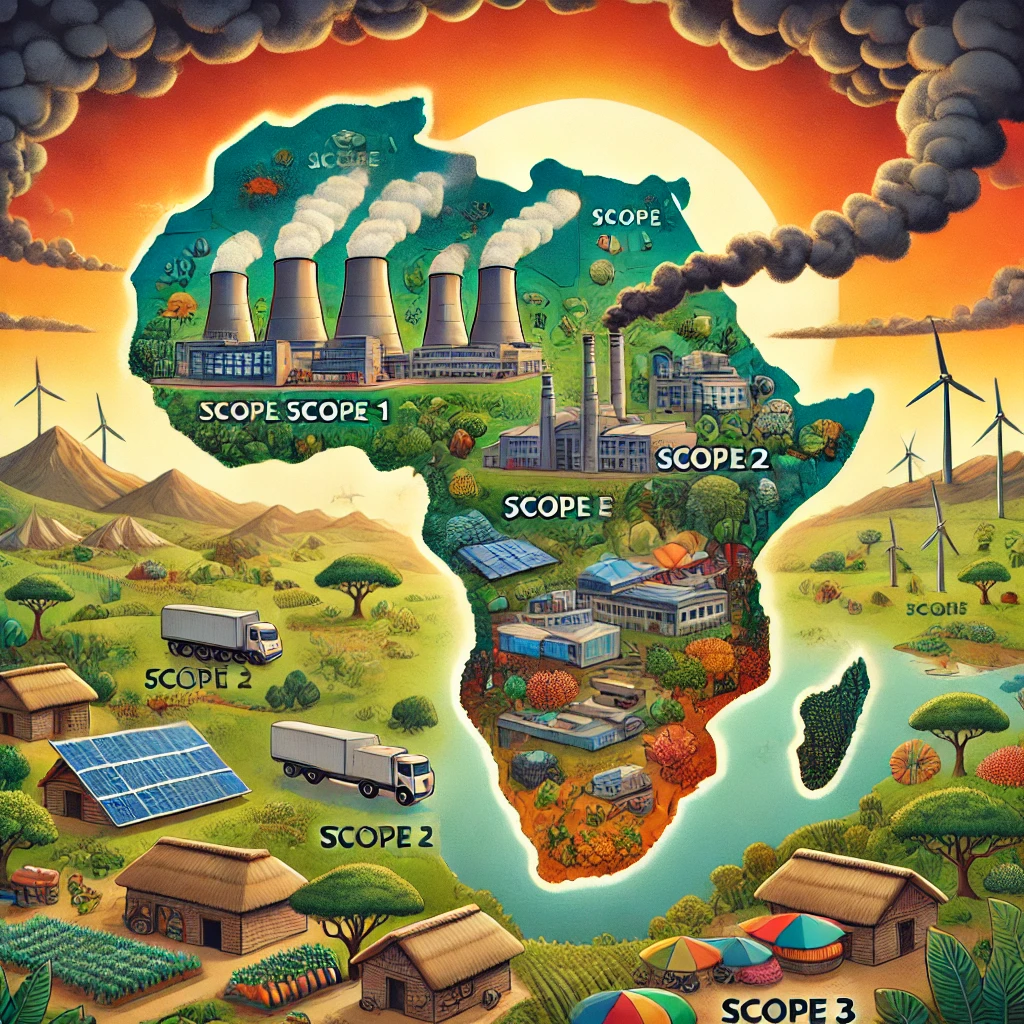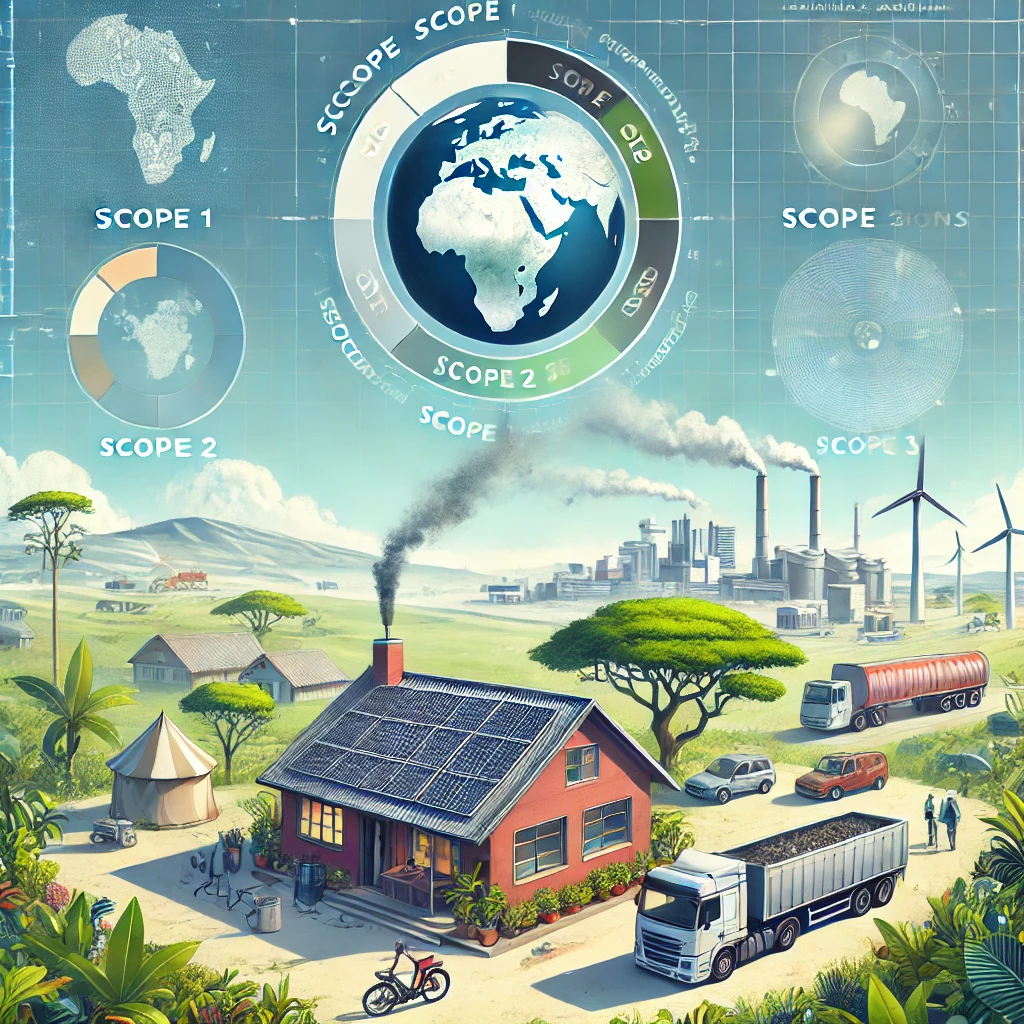As climate responsibility gains traction in global business, understanding and managing greenhouse gas (GHG) emissions has become essential for companies of all sizes. Key to this effort is the GHG Protocol, the leading global standard for measuring and managing emissions, and ISO 14064, an international standard providing guidance on quantifying and reporting GHGs. Central to these frameworks are Scope 1, Scope 2, and Scope 3 emissions, which categorize GHG emissions based on their sources and a company’s level of control.
For small and medium enterprises (SMEs) in Sub-Saharan Africa, adopting these frameworks is vital to managing climate risks, meeting stakeholder expectations, and improving operational efficiency. This guide explains these scopes and their relevance, helping SMEs embark on their sustainability journey.
What Are Scope 1, Scope 2, and Scope 3 Emissions?
The GHG Protocol and ISO 14064 categorize emissions into three “scopes” to standardize reporting:
Scope 1: Direct Emissions
Scope 1 includes emissions that a company directly controls. These come from sources the business owns or operates, such as:
- Fuel combustion: From generators, boilers, or company-owned vehicles.
- Industrial processes: Emissions from manufacturing or production activities.
- Refrigerants: Leaks from air conditioning or refrigeration systems.
Example: A company operating a fleet of delivery trucks is responsible for the fuel-related emissions under Scope 1.
Scope 2: Indirect Energy Emissions
Scope 2 encompasses emissions from purchased energy, such as electricity, heat, or steam. While the company doesn’t generate these emissions directly, it is accountable for the energy it consumes.
Example: A manufacturing SME using electricity from a coal-powered grid must report the associated emissions as Scope 2.
Scope 3: Value Chain Emissions
Scope 3 includes all other indirect emissions resulting from the company’s activities but occurring outside its direct control. These emissions span the entire value chain, both upstream and downstream, and are often the most significant and complex to measure. Categories include:
- Upstream: Emissions from suppliers, transportation, and raw materials.
- Downstream: Emissions from product use, disposal, and distribution.
Example: A retailer’s Scope 3 emissions include the carbon footprint of the goods they source from manufacturers and the emissions from customers using those goods.
Understanding ISO 14064
What is ISO 14064?
ISO 14064 is an international standard for quantifying, monitoring, and reporting GHG emissions. It complements the GHG Protocol by providing a detailed methodology for measuring emissions and verifying reductions. It consists of three parts:
- ISO 14064-1: GHG inventories and reporting.
- ISO 14064-2: Projects aimed at reducing GHG emissions.
- ISO 14064-3: Verification and validation of GHG information.
ISO 14064 ensures transparency, credibility, and consistency in emissions reporting, making it especially valuable for SMEs seeking to build trust with stakeholders.
Comparing the Scopes
| Aspect | Scope 1 | Scope 2 | Scope 3 |
|---|---|---|---|
| Source | Direct emissions from owned/controlled operations. | Indirect emissions from purchased energy. | Indirect emissions across the value chain. |
| Control Level | Full control. | Partial control (dependent on energy providers). | Limited control (dependent on external partners). |
| Examples | Fuel combustion, company-owned vehicles. | Electricity from fossil-fuel grids. | Supplier emissions, product disposal. |
| Measurement Complexity | Low to moderate. | Moderate. | High (often requires extensive collaboration). |
Why It Matters for Sub-Saharan African SMEs
For SMEs in Sub-Saharan Africa, managing Scope 1, 2, and 3 emissions is more than just a compliance exercise—it’s a strategy for sustainable growth.
1. Managing Costs and Improving Efficiency
- Tracking Scope 1 and 2 emissions can reveal opportunities to cut costs by adopting energy-efficient technologies, such as solar power or more efficient vehicles.
2. Building Competitive Advantage
- Businesses reporting and reducing emissions are more attractive to investors, customers, and partners prioritizing sustainability.
3. Mitigating Climate Risks
- Scope 3 emissions often highlight supply chain vulnerabilities. Understanding these emissions helps SMEs build resilience against disruptions such as resource shortages or regulatory changes.
4. Aligning with Global Standards
- As African markets increasingly integrate with global trade, emissions reporting aligned with GHG Protocol and ISO 14064 standards becomes crucial for market access and international collaboration.
Challenges and Solutions for SMEs
Challenges:
- Data Collection: Gathering data for Scope 3 emissions from suppliers and customers is complex.
- Resource Constraints: SMEs may lack the expertise or tools for emissions measurement.
- Energy Dependency: Limited access to renewable energy sources may inflate Scope 2 emissions.
Solutions:
- Simplify Reporting: Start with Scope 1 and Scope 2 before tackling Scope 3.
- Leverage Tools: Use accessible tools like the GHG Protocol’s guidelines and calculators.
- Collaborate: Partner with suppliers and industry groups to share data and resources.
- Invest in Renewables: Explore solar and wind energy options to reduce reliance on carbon-intensive grids.
Taking Action
SMEs can take the following steps to integrate Scope 1, 2, and 3 management into their operations:
- Set Up an Emissions Inventory:
- Use the GHG Protocol or ISO 14064-1 to identify and measure emissions sources.
- Prioritize Reduction Efforts:
- Focus on high-impact areas, such as switching to renewable energy (Scope 2) or optimizing logistics (Scope 1).
- Engage the Value Chain:
- Work with suppliers and customers to address Scope 3 emissions collaboratively.
- Seek Certification:
- Align emissions reporting with ISO 14064 to build trust with stakeholders and access green financing.

Conclusion
Understanding Scope 1, Scope 2, and Scope 3 emissions is a crucial step for Sub-Saharan African SMEs aiming to build sustainable, climate-resilient businesses. The GHG Protocol and ISO 14064 provide robust frameworks to guide this process, enabling companies to measure their impact, reduce emissions, and align with global standards.
By adopting these practices, SMEs not only contribute to global climate goals but also position themselves as forward-thinking enterprises capable of thriving in a rapidly evolving business landscape.


Leave a Reply